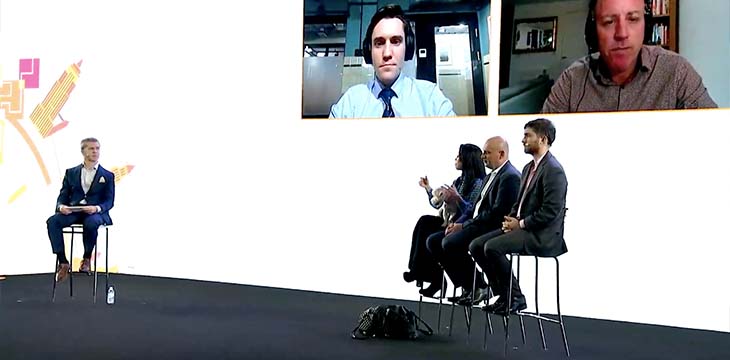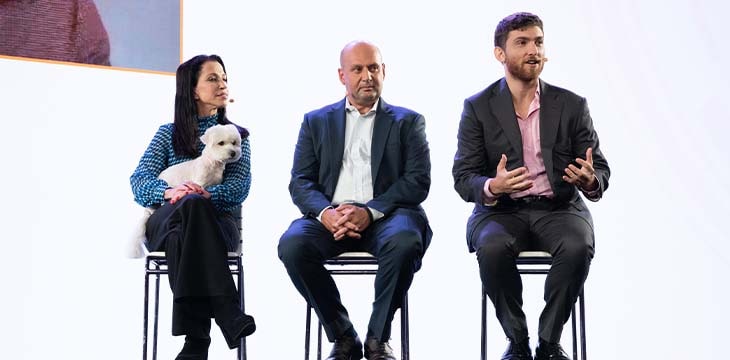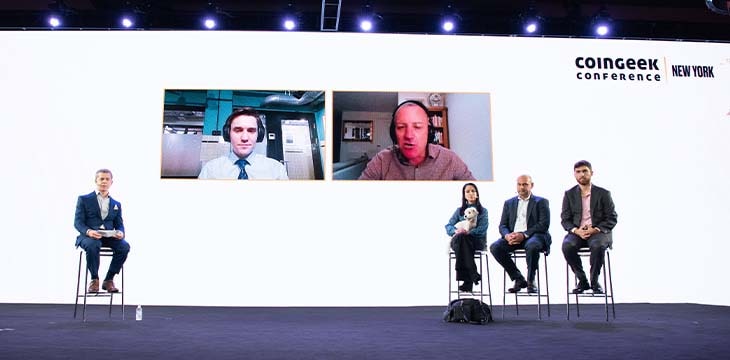|
Getting your Trinity Audio player ready...
|
Investors looking to buy into blockchain-based businesses need to come off the sidelines and make a play, lest they find themselves too far behind the game to make any impact.
The final day of the CoinGeek Conference in New York saw Ayre Ventures’ Managing Director of Private Equity Paul Rajchgod moderate the “Investing in Blockchain Ventures” panel. Rajchgod, who earlier in the Conference delivered a solo presentation on how Ayre Ventures chooses its investments, decided to take the temperature of a number of other blockchain-based investment firms.
Joining Rajchgod onstage were Wendy Diamond – Founder & CEO, LDP Ventures; Alex Fauvel – co-founder & General Partner, Two Hop Ventures; Roman V. Livson – CFO, Burkhan World Investments; Craig Massey – Chairman, Satoshi Block Dojo; and Zach Resnick – Managing Partner, Unbounded Capital.

Ayre Ventures focuses its investments on projects built on the infinitely scaling BSV blockchain, and Rajchgod quizzed the panel on how the issue of scalability factored into their evaluation of potential investments. Livson, who in addition to his Burkhan role is a principal at New York investment bank Capitalist Securities, said scalability was “critical” to his decision process, particularly in terms of how companies pitch their technology to prospective customers.
Livson said he watched how companies explained the ways their tech would enhance return on investment for their customers. Leveraging BSV to outsource back office functions will reduce the scope of initial investment, while BSV’s ability to significantly reduce transaction costs increases operating leverage.
Unbounded’s Resnick said his firm targeted Bitcoin infrastructure companies that allow other companies and consumers to enjoy Bitcoin’s advantages without them needing to understand the technology itself. Unbounded was less concerned about “who’s going to build the next great game or consumer product,” choosing instead to prioritize “who’s going to allow projects like that to be more easily built.”
As an example, Resnick cited the RUN protocol, which he called the “most used tokenization protocol, not just on BSV, but in blockchain as a whole.” Among those leaning heavily on RUN was FYX Gaming and its flagship CryptoFights product, which registers hundreds of thousands of daily transactions on the BSV blockchain.

Two Hops’ Fauvel said a major concern of his group was how individuals remained in control of the growing volume of data they’re putting onto the blockchain. The current model is offloading responsibility for personal data onto data processors, but if you know a better way to securely store data on a blockchain, you have a duty to use it (assuming it’s economically viable). “That’s going to be the trillion-dollar business we’re all looking for.”
LDP’s Diamond—who was joined onstage by her dog Happy—said scalability was important but her startup investment focus tended to be on businesses that aim to empower and uplift female entrepreneurs. Diamond cited an investment in Producers Market, which directly connects smaller farms—that in countries such as India are primarily run by women—with buyers using blockchain technology.
All ahead slow for enterprise adoption
Enterprise adoption is a primary focus of the BSV ecosystem, and Rajchgod asked the panel when we might see more signs of this dam breaking. Massey, whose Satoshi Block Dojo serves as a tech incubator, says enterprises tend to move slowly, but in two to three years’ time many will wake up to what they’re missing and simply “buy their way to the front,” hopefully snapping up many of his startups in the process.
Massey said he’s witnessing a “massive transformational shift” among corporations seeking “more robust, hybrid solutions involving databases and blockchain” and “interoperability makes more sense than an IT mish-mash building on multiple blockchains.” Massey added that “nothing focuses a CEO’s mind more than the bottom line,” particularly when coupled with the sight of a competitor gaining a competitive advantage through BSV. If the block size can raise to 4Gb, the increased transaction volume will improve the economics of switching and further enhance BSV’s appeal.
Resnick drew attention to the “big elephant in the room,” namely, the “negative PR” surrounding BSV thanks to the concerted efforts of supporters of rival blockchains. Resnick said there are large enterprises that have done their technical due diligence on BSV but balk after their CEO does a quick Google search and reads the BSV antagonists’ preferred narrative.

Resnick cited the example of some “crypto consensus folks” who publicly praise the likes of Solana or Ethereum but will only invest with Unbounded under non-disclosure agreements to mask their public association with BSV. That said, Resnick expressed confidence that these private investments will ultimately feel secure enough to make themselves public, which will encourage more enterprises to come out of the shadows.
Rajchgod noted that not all enterprises feel the need to publicly declare their B2B shifts, citing some Veridat pharma customers putting data on-chain without a public announcement. Rajchgod also noted an earlier conference presentation by Niels van den Bergh that referenced Visma, an Oslo-based company that serves as the leading European supplier of business-critical software, which currently ranks as a top-five daily transaction generator on BSV.
Institutionalized
Some new institutional investors recently made their debuts in the BSV ecosystem, with Rajchgod citing recent funding announcements by the likes of Transmira, Blarecast and BuzzCast. But Rajchgod wondered when the ecosystem would welcome major VCs such as Andreessen Horowitz and Tim Draper. Or does their non-presence matter?
Fauvel said BSV’s ecosystem isn’t yet big enough to draw attention from major VCs, but by the time they do wake up to this opportunity, it may be too late. “The VCs were right about the internet because that’s their domain. Blockchain is different, it’s our domain, we know this industry better than them. We can spot value before them and get in there and then they’ll be following up.”
Massey took a slightly different stance, saying VCs will be a “massive important part of the funding mix.” Massey’s group wants its companies on the VC radar so it’s built a network of 130 smaller VCs and family offices, getting them to invest a relatively token amount—“a couple hundred grand at seed stage”—so that when the time comes for a proper VC round, Massey’s tech babies won’t be complete unknowns to his VC partners.
Livson said it was important to “get in before the bandwagon,” a goal that will get a major boost from his group’s plans to launch three special purpose acquisition vehicles (SPACs) to acquire blockchain-based businesses. The SPACs, backed by $250 million apiece, will each focus on one of three areas: fintech/proptech; artificial intelligence, and media. Having partnered with “some of the smartest money in the world,” the targets of these SPACs will be “disruptors in their space,” and while those targets have yet to be identified, there’s a “good chance” that some will be from the BSV ecosystem.
ESG & BSV
Another way to increase major VC interest would be to ease concerns about the highly publicized environmental, social and governance (ESG) issues sparked by inefficient tokens such as BTC and ETH. Resnick’s group has produced a book, “Green Bitcoin: How Bitcoin Can Be A Climate Change Solution,” which details how BSV is not just the most energy-efficient blockchain, but is already on par with Visa in terms of energy per transaction and will ultimately leave Visa in the dust as BSV crams ever greater transaction volumes into each block on the chain.
Livson’s crew has a plan to make digital currency investing more attractive from an ESG standpoint by bundling assets like Bitcoin with certificates issued by renewal energy agencies. The bundle would add a 2 percent premium to the asset price, half of which would go toward mining operations powered by wind/hydro/solar energy, while the other half would go toward environmental agencies involved in planting trees and to build more green-friendly mining infrastructure. The plan is still in the early stages, but Livson sees it as a win-win for investors and the planet.
As for the social part of ESG, Diamond said the blockchain community offers many opportunities for women, but there’s just not enough women applying for these jobs, so some kind of awareness campaign needs to be launched ASAP. Diamond herself got into this space after hearing the story of a woman in Botswana who was an early adopter of Bitcoin, started a Satoshi Center in her homeland and is now advising the local government on blockchain-related issues.

Fauvel closed the show by noting that Bitcoin has two processes: hashing and computing, with the ratio between these processes being how we measure efficiency and effectiveness. The more computing you do on Bitcoin, the less fraud there is, because it’s public. Fauvel called fraud the biggest environmental threat, because an estimated 10% of the overall economy is fraud-based, and with so much fraud going undetected, the true percentage could be three times that figure.
Even if it is only 10%, that’s still $8 trillion lost to fraud. By removing fraud from the economy, Bitcoin could dramatically cut the volume of overall transactions, thereby lowering their environmental impact. The public could now invest in honest businesses and products, and even if they lie, there’s a public record of their lie with which to hold them accountable.
Environmentally friendly fraudbusters… someone call Marvel, as their universe is missing a new hero.
Watch CoinGeek New York 2021 Day 3 here:

 01-07-2026
01-07-2026 




